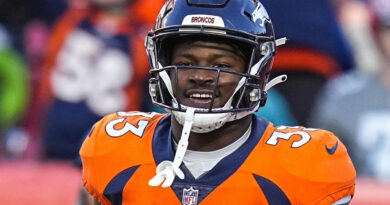Media Buying Briefing: Why sports investment is a lot more complex than it used to be
This Media Buying Briefing covers the latest in agency news and media buying for Digiday members and is distributed over email every Monday at 1src a.m. ET. More from the series →
This year’s Super Bowl was unlike any other, generating record-smashing ratings thanks in part to the Taylor Swift effect.
March Madness has begun, and it’s like none that have come before it because the women’s game is more popular than ever, thanks to Iowa star Caitlin Clark. And superstar Lionel Messi has elevated the international favorite futbol into a major draw for American fans thanks to his joining Major League Soccer’s Inter Miami.
Concurrent with all this change and attention is the fact that fashion and music — pop culture, in other words — is now as attached at the hip of most sports, attracting new advertisers drawn to the expanded fan base.
All the above has created a complex marketplace for sports media buyers looking to attach their client(s) to the rabid fan base attached to a team or a sport, or even a league. But the hard work, agreed several sports investment executives, can pay off in dividends for marketers who succeed in making that attachment organically. It means looking at experiential, using influencers, ensuring SEO is up to snuff when fans look up your brands, buying into that league’s apps, and even directly negotiating with star athletes.
“Yes, the complexity is there, but remember, the only reason that you do sponsorships and experiential is for the borrowed equity, the borrowed audience, to change perception of you your brand, or connect with a new audience,” said Chris Weil, founder and co-CEO of Horizon Sports & Entertainment, which operates on the principle that live, be it sports, music or other entertainment, is where brands need to be. “Borrowed equity programming, as I call it, needs to move to the center of the marketing plan, and advertising and media plan, not as a support to a brand campaign. Because this is the essence of where the audience is. And we need to build our communications around this.”
In other words, this ain’t your father’s sports marketplace anymore. “It’s gone from a reach and frequency game of getting your message across, to an emotional connection and a passionate connection” between brand and fan, said Weil.
“It’s about that full funnel approach to ensure that you bring that person in versus one thing that is like the trigger for that person to take action,” added Chris Walsh, head of media technology and activation at Apollo Partners, which helped lesser-spending clients like Coupa get attached to big sports events through routes that didn’t involve national TV buying.
“From a marketer’s perspective, it’s great to see a wealth of opportunities and wealth of inventory to place your advertisements in front of consumers,” said Walsh. “And we really have to figure out how do you connect the dots between those ecosystems and other ecosystems, ultimately ensuring that we’re providing consumers with what they’re looking for and giving them —what’s the old adage? — the right message at the right time in the right place.”
Sports media sellers like Playfly preach this fan-first philosophy all the time, as well as the notion of finding those fans in the other places they show up — rather than just with TV sports in the national game. Through lots of data crunching, the company also assesses the fan value of teams through a new offering called Fanscore. It just launched a version of it applied to the NBA and its teams and fanbases.
“It allows us to look at fandom from all different levels, from a media perspective, from a team commercial perspective, from a fan receptivity level,” said Michael Schreiber, founder and CEO of Playfly. “When you look at like fan receptivity for teams, you think it’s only going to be the Knicks and the Lakers and the Warriors at the top. But you’re starting to see the [Oklahoma City] Thunder, and the [Orlando] Magic show up in the top five, in terms of who has some of the most passionate fans.”
It’s the difference between a “media spend being an expense or an investment” that can lead to a “lifelong relationship,” said Craig Sloan, Playfly’s president, who said he believes the sports ad marketplace will be a seller’s market now that it’s front and center part of the upfront offerings of the major content providers.
“With the primetime entertainment fan that you found and you made a connection to that fan, when that’s off the air in three to five years, you have to go restart that engine again. Whereas if they find you as a sports fan, and they’ll continue to have that relationship with you over the decades,” he said.
Jeff Gagne, svp and group client lead at Havas Media Network, said companies like Playfly help navigate some of the more complex areas, like regional sports networks that are morphing from linear channels to streaming and other forms. “The regional space can be very difficult to navigate — and companies like Playfly have become partners that can simplify what’s a complicated market.”
No one said it would be easy, but buyers believe the effort is worthwhile. “It’s tricky to figure out what’s right,” said Adam Schwartz, svp director of national broadcast, sports media at Horizon Media. “You want a good balance — you want to get some reach and make sure you’re reaching a ton of eyeballs. But some of those smaller sites are where the passionate fans live. There is a lot of unduplication [from TV audiences] on some of those smaller sites, so you want to make sure you’re getting them and you know what you’re getting there. And those people will be loyal to your brand if you’re attached in the right manner and an organic way.”
“Sports is expensive for all our advertisers, so if there’s ways for us to engage directly with the athletes and get around the leagues — whether that’s through social opportunities through the players associations or that we have with influencers — it’s really important to make sure we’re investigating all those avenues for our clients,” said the head of sports investment at a major holding company buying group, who declined to speak for attribution.
And if you think the investment part is harder, the post-campaign measurement part is even more complex, given the challenges of identity, the fragmentation of measurement and the lack of cross-media analysis.
Angelique Hernandez, vp and portfolio lead at Havas Play, which is in the business of connecting brands to consumer passions, noted it’s important to remember that sports fans aren’t one-dimensional. “Sports fans aren’t only that — they love music, fashion and other things,” she said.
But Hernandez also pointed out that the inclusion of fashion and music has helped widen the tent of opportunity for a broader array of advertisers that historically would never have considered sports as a marketing opportunity. “It’s called tunnel fashion and it can attract luxury or jewelry” advertisers, she said, reaching what she dubbed even the “sports-adjacent fan.”
Color by numbers
It turns out we use social media for more than brunch pics and pet videos. Language app Preply surveyed 1,srcsrcsrc Americans on their experiences with learning on social media platforms, and it found that people spend more than five hours a week learning on social media. — Antoinette Siu
More highlights:
- The top social platforms for learning are Reddit, TikTok and Facebook, in that order.
- Most popular topics: health and wellness, cooking and baking, technology.
- 87% are learning about politics on social networks, and 97% are learning about cultures and finding it exposes them to more perspectives.
- Exploring languages is also popular — more than one in four use social media for learning a language (34% are Gen Z and 29% millennial).
Takeoff & landing
- The &Partnership and mSix@Partners are combining into one full service agency called T&P, and say the underpinning of the merged operation is AI to break down the classic silos between media and creative. Clients include Toyota and News Corp.
- Account wins: Omnicom’s performance shop TCA landed media AOR duties in the U.S. and Canada for HVAC and plumbing firm Ferguson … Stagwell’s Gale landed media and creative duties for Brazilian restaurant chain Fogo de Chão … PMG landed media AOR duties for Solo Brands, which includes Solo Stove, Chubbies and other brands … Brandtech Group’s Jellyfish landed media duties for milk alternative Oatly in 4src markets … IPG’s Media Experts in Canada will handle all planning and buying duties for Honda Canada.
Direct quote
“The fundamental difference [between Hollywood and Madison Avenue] is that our business models are so different. [In Hollywood], they do a deal, hang up the phone, the lawyers pay for it and they make the money. [In the agency world], we do a deal, hang up the phone — and then we have to go earn our money. When I land a new client, I’ve not made one dollar — I have to then go and put the hours in and make the dollars. It’s the essence of why it can’t work.”
— Chris Weil, founder and co-CEO of Horizon Sports & Entertainment, musing on the public spat between MediaLink’s Michael Kassan and UTA.
Speed reading
- Antoinette Siu explains the thinking behind agencies showing up at tech conferences like Nvidia’s shebang last week, and what their goals are. Hint: it’s got a lot to do with AI.
- Krystal Scanlon dives into Reddit’s hugely successful IPO last week and why many in the agency business are still trying to figure out how to use it as part of their media investments.
- Kimeko McCoy offered a solid overview of how media buyers perceive the main retail media network players.



